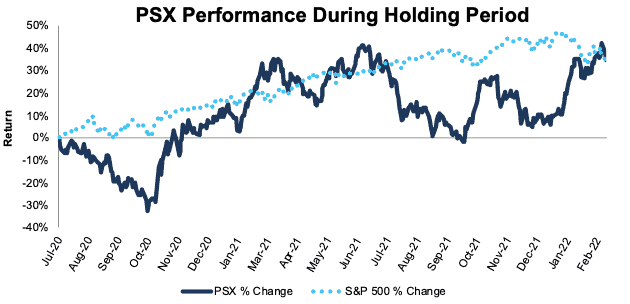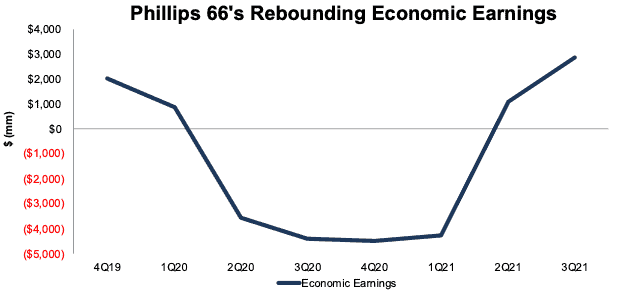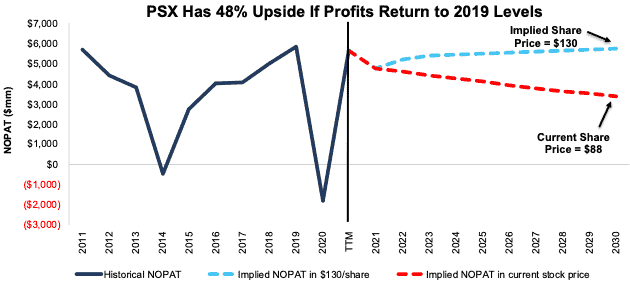We published an update to this Long Idea on February 7, 2024. A copy of the update report is here.
We made Phillips 66 (PSX: $88/share) a Long Idea in July 2020, as part of our “See Through the Dip” thesis. Since then, the stock is up 35% compared to a 37% gain for the S&P 500. This stock has even more room to run and could be worth $130+/share.
We leverage more reliable fundamental data, as proven in The Journal of Financial Economics[1], with qualitative research to pick this Long Idea. Our proprietary research provides a new source of alpha.
Phillips 66’s Stock Could Go 43+% Higher
- Our “See Through the Dip” thesis has proven true as the firm’s operations and economic earnings recover from the COVID-19-induced “dip”.
- Phillips 66’s diversified business segments, complex refineries, and investments in decarbonization will fuel steady cash flow generation going forward.
- Rising environmental standards are likely to push competitors with less-advanced refineries out of the market.
- Phillips 66’s stock is priced as if profits will remain 40% below current levels.
Figure 1: Long Idea Performance: From Date of Publication Through 2/15/2022
Sources: New Constructs, LLC and company filings
What’s Working
Operations Are Recovering: The company’s refinery segment saw improved volumes and an increase in realized margins, from $8.57 per barrel in 4Q20 to $11.60 per barrel in 4Q21. Lower prices for RINs (renewable credits) and a reduction in RIN obligations contributed to the gain in realized margins.
Phillips 66’s rebound in GAAP earnings in 4Q21 should be no surprise to investors that look beyond the income statement to get at the company’s true profitability. The company’s net operating profit after tax (NOPAT) improved YoY in each of the past three quarters. Over the trailing twelve months (TTM) through 3Q21, Phillips 66’s NOPAT of $5.7 billion is much higher than GAAP earnings of -$508 million over the same time.
“See Through the Dip” Paid Off: In our original report, we posited that the company’s downward profit trend was temporary and hid the company’s long-term potential to generate profits. Profitability has recovered each quarter since 4Q20 and Phillips 66’s TTM NOPAT margin rose from -3% in 4Q20 to 6% in 3Q21, while invested capital turns rose from 1.2 to 1.7 over the same time. Rising NOPAT margins and improving invested capital turns drive the company’s TTM return on invested capital (ROIC) higher, from -3% in 4Q20 to 10% in 3Q21. Per Figure 2, Phillips 66’s TTM economic earnings rose from -$4.5 billion in 4Q20 to $2.9 billion in 3Q21 and are 42% higher than 4Q19 levels.
Figure 2: TTM Economic Earnings: 4Q19 – 3Q21
Sources: New Constructs, LLC and company filings
Diversified Business Creates Multiple Profit Streams: In addition to refining, the company’s chemicals, specialty products, and midstream segments contribute to the bottom-line. This diversified approach enables the company to leverage its large footprint and mitigate threats to its refining segment.
Furthermore, the company is investing for the future through producing chemical products from recycled materials, investing in battery technology, and generating renewable diesel. These alternative products prepare the company for a decarbonized future.
What’s Not Working
Waning Demand for Refined Products: S&P Global Platts expects U.S. gasoline demand to peak in 2023, which means the U.S. refiners could have difficulty growing operations domestically. However, even with less demand in the U.S., increased global demand will keep complex U.S. refineries, such as those in Phillips 66’s portfolio, in demand beyond 2023.
Phillips 66’s complex refineries stand to gain as low-complexity refineries shutdown. Refining rationalization is already occurring. It is noteworthy that 2021 was the first year, in at least 30, where more global refining capacity was removed than added. While demand for fuels to move people and goods is rising rapidly, capacity is shrinking. The survivors will reap the rewards.
Doubts Around the Viability of Phillips 66’s Renewable Diesel Operation: The rise of renewable diesel projects across North America leave many investors wondering if there is enough feedstock to supply and enough demand to satisfy such a rapid increase in capacity. Phillips 66, however, has sourced a broad range of feedstocks that the company can access through a network of internal and external suppliers. Through its ownership in Shell Rock Soy Processing, aggregation of used cooking oil, strong relationships with vegetable oil producers, global storage, and easy access to foreign feedstock, Phillips 66 is well-positioned to optimize its renewal diesel operations with a variety of feedstock options.
The company’s Rodeo facility will supply California, which leads the U.S. renewable diesel industry in renewable diesel demand.
Phillips 66 Is Priced as if Profits Will Remain 40% Below Current Levels
Below, we use our reverse discounted cash flow (DCF) model to analyze the expectations for future growth in cash flows baked into a couple of stock price scenarios for Phillips 66. Though the company’s TTM NOPAT is nearing pre-pandemic levels, its stock is priced as if profits a decade from now will remain 40% below TTM levels.
In the first scenario, we assume Phillips 66’s:
- NOPAT margin falls to 4% (equal to pre-pandemic 5-year average from 2015 – 2019 vs. 6% TTM) from 2021 – 2030, and
- revenue falls by 4% compounded annually from 2022 – 2030 (vs. consensus estimates of +8% in 2022 and +4% in 2023).
In this scenario, Phillips 66’s NOPAT in 2030 is just $3.4 billion, or 22% below the company’s average pre-pandemic NOPAT from 2015 – 2019 and 40% below TTM levels, and the stock is worth $88/share today – equal to the current price.
Phillips 66 Could Reach $130 or Higher
If we assume Phillips 66’s:
- NOPAT margin falls to 4% from 2021 – 2030,
- revenue grows 8% in 2022 and 4% in 2023 (equal to 2022 – 2023 consensus estimates), and
- revenue grows by just 1% compounded annually from 2024 – 2030, then
the stock is worth $130/share today – 48% above the current price. In this scenario, Phillips 66’s NOPAT in 2030 is $5.8 billion, or equal to 2019. Should Phillips 66’s NOPAT rise above pre-pandemic levels, the stock has even more upside.
Figure 3: Phillips 66’s Historical and Implied NOPAT: DCF Valuation Scenarios
Sources: New Constructs, LLC and company filings
This article originally published on February 16, 2022.
Disclosure: David Trainer, Kyle Guske II, and Matt Shuler receive no compensation to write about any specific stock, sector, style, or theme.
Follow us on Twitter, Facebook, LinkedIn, and StockTwits for real-time alerts on all our research.
[1] Our research utilizes our Core Earnings, a more reliable measure of profits, as proven in Core Earnings: New Data & Evidence, written by professors at Harvard Business School (HBS) & MIT Sloan and published in The Journal of Financial Economics.



